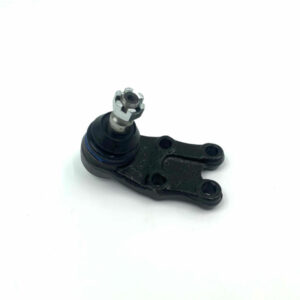The specific steps for replacing a ball joint can vary depending on the vehicle make and model.
However, here is a general outline of the process:
Prepare the vehicle: Park the vehicle on a level surface and engage the parking brake. Lift the front of the vehicle using a jack and support it securely on jack stands. Ensure the vehicle is stable before proceeding.
Remove the wheel: Use a lug wrench or impact wrench to remove the wheel nuts. Take off the wheel and set it aside.
Access the ball joint: Depending on the vehicle, you may need to remove other components to access the ball joint. This can include removing the brake caliper, brake rotor, or other suspension components. Follow the vehicle manufacturer’s instructions or a repair manual specific to your vehicle.
Disconnect the ball joint: The ball joint is typically secured to the control arm or steering knuckle with bolts or nuts. Remove these fasteners to disconnect the ball joint from the respective components. You may need to use a wrench, socket set, or specialized tools such as a ball joint separator or pickle fork.
Remove the ball joint: Once the ball joint is disconnected, it may be pressed or bolted into place. If it is pressed, you will need a ball joint press tool to remove it. If it is bolted, use suitable tools to remove the bolts.
Install the new ball joint: Position the new ball joint in place and ensure it aligns correctly with the control arm or steering knuckle. Depending on the type of ball joint, you may need to use a press or tighten specific bolts to secure it. Follow the manufacturer’s instructions for proper installation.
Reassemble components: Put back any components that were removed to access the ball joint, such as the brake caliper, brake rotor, or suspension parts. china ball joints manufacturer Ensure all fasteners are tightened to the specified torque values.
Reinstall the wheel: Place the wheel back onto the wheel hub and hand-tighten the lug nuts. Lower the vehicle back to the ground and use a torque wrench to tighten the lug nuts to the manufacturer’s recommended torque.
Test and align: Once the ball joint replacement is complete, perform a test drive to ensure proper operation. It is also recommended to have the vehicle’s alignment checked and adjusted by a professional to ensure proper wheel alignment.
It’s important to note that the above steps are a general guideline, and the specific process may vary depending on the vehicle make, model, and other factors. Always consult the vehicle manufacturer’s instructions or a repair manual specific to your vehicle for detailed and accurate instructions. If you’re not experienced with automotive repairs, it may be best to seek the assistance of a qualified mechanic.
How does a ball joint work in a suspension system?
A ball joint is a crucial component of a suspension system in a vehicle. It serves as a flexible pivot point between the control arm and the steering knuckle, allowing for controlled movement and articulation of the suspension. Here’s how a ball joint works in a suspension system:
Connection between control arm and steering knuckle: The ball joint is typically located at the bottom of the control arm and connects it to the steering knuckle or spindle. It is designed to withstand both vertical suspension movement and steering motion.
Ball and Socket Design: A ball joint consists of a spherical bearing (ball) enclosed within a socket. The ball is attached to the control arm, while the socket is part of the steering knuckle or spindle assembly. The ball and socket are usually made of hardened steel for durability.
Lubrication: The ball joint is usually greased or has a lubrication point to ensure smooth movement and reduce friction between the ball and socket. This allows for improved articulation and reduces wear on the joint.
Articulation and Movement: As the suspension moves up and down, the ball joint allows the control arm to pivot and rotate within the socket. This movement accommodates the changes in wheel position, absorbs road imperfections, and provides a comfortable ride.
Steering Function: In addition to suspension movement, the ball joint also plays a role in steering. When the steering wheel is turned, the ball joint allows the steering knuckle to pivot, enabling the wheels to turn and change direction.
Load Transmission: The ball joint transfers the weight of the vehicle from the control arm to the steering knuckle. It helps support the weight of the vehicle and the forces encountered during braking, accelerating, and cornering.
Wear and Maintenance: Over time, the ball joint may experience wear due to the constant movement and load it bears. Excessive wear can lead to looseness, play, or failure, resulting in compromised suspension performance and potentially unsafe driving conditions. Regular inspection and maintenance are important to detect any signs of wear or damage and replace the ball joint if necessary.
By allowing controlled movement and articulation while supporting the weight of the vehicle, the ball joint contributes to the stability, handling, and overall performance of the suspension system in a vehicle. Proper maintenance and timely replacement of worn ball joints are essential for ensuring safe and smooth operation.
